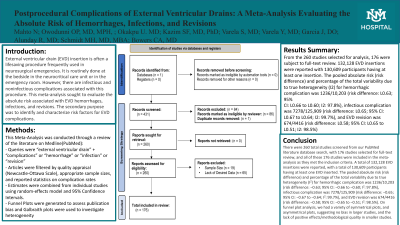Postprocedural Complications of External Ventricular Drains: A Meta-analysis Evaluating the Prevalence of Hemorrhages, Infections, and Revisions.
Postprocedural Complications of External Ventricular Drains: A Meta-analysis Evaluating the Prevalence of Hemorrhages, Infections, and Revisions
Friday, April 21, 2023


Neil Mahto (he/him/his)
Pre-Med
University of New Mexico Hospital
ePoster Presenter(s)
Introduction: External ventricular drain (EVD) insertion is often a lifesaving procedure frequently used in neurosurgical emergencies. It is routinely done at the bedside in the neurocritical care unit or in the emergency room. However, there are infectious and noninfectious complications associated with this procedure. This meta-analysis sought to evaluate the pooled prevalence rates associated with EVD hemorrhage, infection, and revision. The secondary purpose was to identify and characterize risk factors for EVD complications.
Methods: MEDLINE was searched to identify studies that were pertinent. Estimates from individual studies were combined using a random effects model, and 95% confidence intervals (CI) were calculated with exact Poisson specification. To investigate heterogeneity, the t2 and I2 tests were utilized. To evaluate for publication bias, a funnel plot was developed.
Results: There were 260 total studies screened from our PubMed literature database search, with 176 studies selected for full-text review, and all of these 176 studies were included in the meta-analysis as they met the inclusion criteria. A total of 132,128 EVD insertions were reported, with a total of 130,609 participants having at least one EVD inserted. The pooled prevalence rate for hemorrhagic complication was 1236/10,203 (Proportion: 0.09; 95% CI 0.07, 0.12), infectious complication was 7278/125,909 (Proportion: 0.08; 95% CI 0.07, 0.10) and EVD revision was 674/4,416 (Proportion: 0.11; 95% CI 0.08, 0.16). The pooled prevalence showed evidence of significant heterogeneity (p < 0.01) for these complications.
Conclusion : In conclusion, these findings provide valuable information regarding the safety of one of the most important and most common neurosurgical procedures: EVD insertion. Implementing best-practice standards is recommended in order to reduce EVD-related complications. There is a need for more in-depth research into the independent risk factors associated with these complications, as well as confirmation of these findings by well-structured prospective studies.
Methods: MEDLINE was searched to identify studies that were pertinent. Estimates from individual studies were combined using a random effects model, and 95% confidence intervals (CI) were calculated with exact Poisson specification. To investigate heterogeneity, the t2 and I2 tests were utilized. To evaluate for publication bias, a funnel plot was developed.
Results: There were 260 total studies screened from our PubMed literature database search, with 176 studies selected for full-text review, and all of these 176 studies were included in the meta-analysis as they met the inclusion criteria. A total of 132,128 EVD insertions were reported, with a total of 130,609 participants having at least one EVD inserted. The pooled prevalence rate for hemorrhagic complication was 1236/10,203 (Proportion: 0.09; 95% CI 0.07, 0.12), infectious complication was 7278/125,909 (Proportion: 0.08; 95% CI 0.07, 0.10) and EVD revision was 674/4,416 (Proportion: 0.11; 95% CI 0.08, 0.16). The pooled prevalence showed evidence of significant heterogeneity (p < 0.01) for these complications.
Conclusion : In conclusion, these findings provide valuable information regarding the safety of one of the most important and most common neurosurgical procedures: EVD insertion. Implementing best-practice standards is recommended in order to reduce EVD-related complications. There is a need for more in-depth research into the independent risk factors associated with these complications, as well as confirmation of these findings by well-structured prospective studies.
